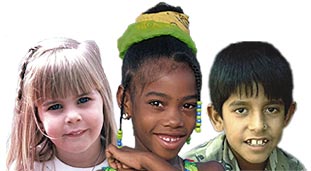|
Genetic
Diversity
Diversity also
refers to the range of characteristics or traits found within a
single species. Some traits you can't see, like blood type or resistance
to certain diseases. But other traits you can see. For instance,
you can find individual human beings who are tall and thin, short
and stout, or every other combination you can think of. Their arms
may be long or short. Their noses and ears may be big or small.
Their hair may be blond, red, brown, or black. Their eyes may be
blue, green, brown, or black. Their skin may be white, yellow, brown,
or black.

These
traits arise from the genes that parents pass on to their offspring.
The appearance of a given trait in an individual depends on the
laws of inheritance. Despite the wide range of appearances, all
humans are members of the same species. The many different traits
found in different individuals simply show that there is great
genetic diversity within the human species. Photos
© 2000-www.arttoday.com
Large populations
of a given species living over broad areas of Earth tend to have
great genetic diversity. Small populations tend to have limited
genetic diversity. A species with few members tends to get weaker
from generation to generation because genes for bad traits, like
decreased fertility or heart abnormalities, spread easily through
small populations. Thus, the survival of a species that has been
reduced to a few hundred or a few dozen individuals, like the
mountain gorillas in Rwanda and the panthers in Florida, is threatened
because of the lack of genetic diversity.
|











